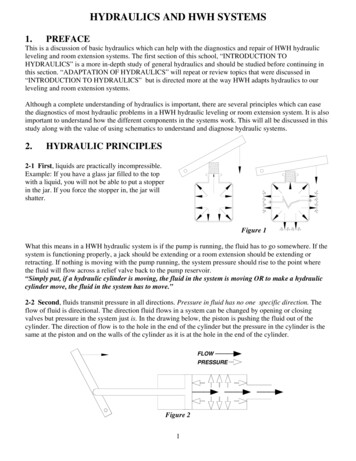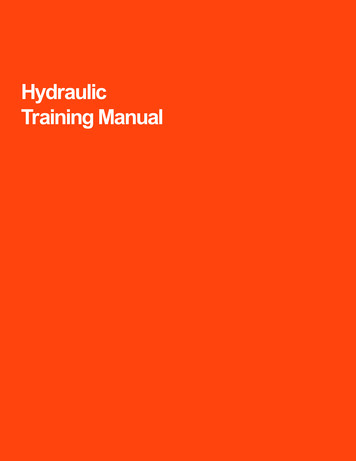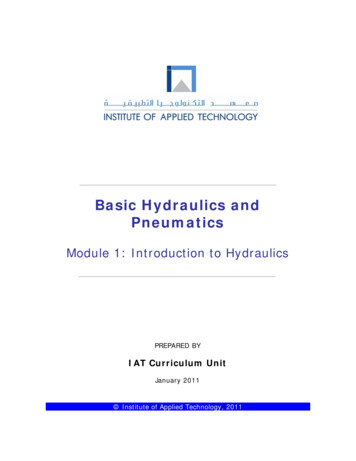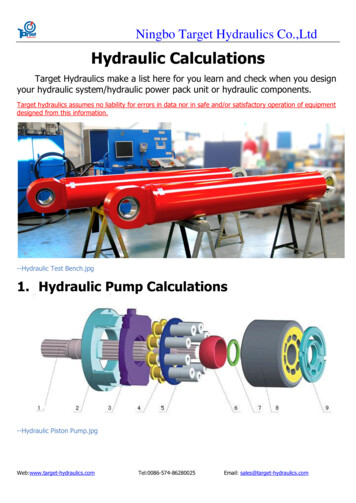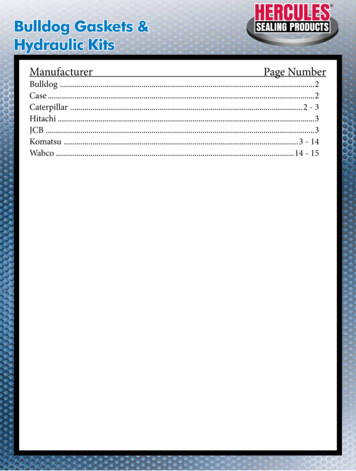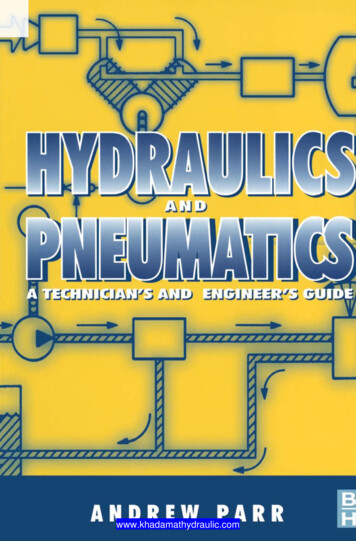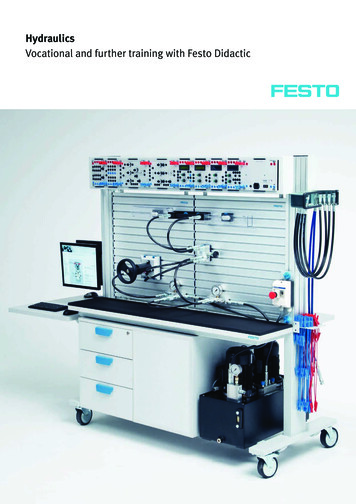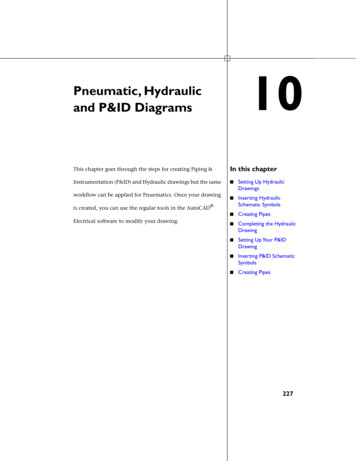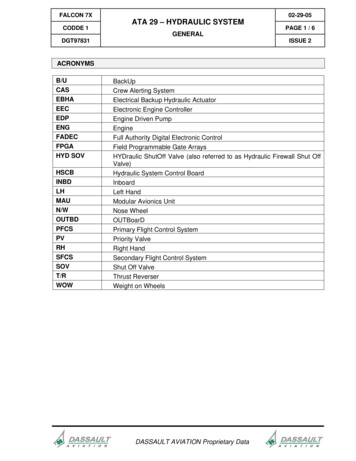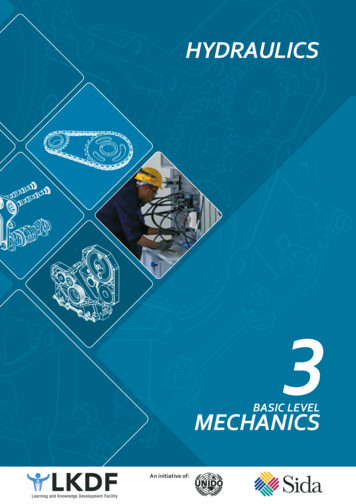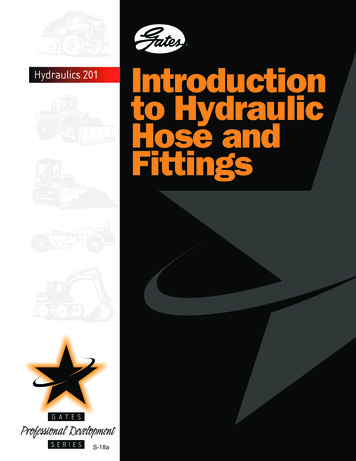
Transcription
Hydraulics 201S-18aIntroductionto HydraulicHose andFittings
i n t r o d u c t i o nIntroduction toHydraulic Hoseand Fittingst oH Y DR A U L ICH O S EA NDF ITTIN G S2 0 1Table of ContentsFundamentals of Hydraulic Hose and Fittings. Page 2Hose Construction. Page 3Selecting the Right Hose. Page 5Gates SAE Hose Nomenclature. Page 11Hydraulic Hose Applications. Page 13Hydraulic Fluids . Page 22Hose Storage. Page 23Couplings. Page 25Coupling Identification. Page 27Adapters. Page 44Proper Hose Assembly. Page 45Assembly Preparation – Hose, Coupling and Crimping. Page 48Installing Hose Assemblies. Page 54Troubleshooting: Hose Failure. Page 58Crimpers. Page 63Crimper Troubleshooting. Page 65Glossary. Page 69Level 201 Review Quiz. Page 76
i n t r o d u c t i o nt oH Y DR A U L ICH O S EA NDF ITTIN G S2 0 1Fundamentals of Hydraulic Hose and FittingsWhy use hydraulic hose assemblies?Hydraulic hose replaced the ridged pipes and tubes used in early hydraulicsystems because a hose:n Is less costlyn Weighs lessn Is better able to absorb shock and vibrationn Is easier to route and installn Needs no brazing or specialized bendingn Allows for movement between components of equipmentn Is less likely to rustn Absorbs sound bettern Dampens pressure surgesThe internationalmarketplace forhydraulicassemblies isgetting largerevery day. Fundamentals ofHydraulicsHydraulic101Hose and Fittings
ii nn tt rr oo dd uu cc tt ii oo nntt ooHH YY DRDR AA UU LL ICICHH OO SS EEAA NDNDFF ITTINITTIN GG SS22 00 11Hose ConstructionA hose is made up of three components:ReinforcementThe availability androuting advantagesof hose make it thepreferred choiceover tubing bymaintenancepersonnel.CoverTubeThe TubeThe Tube is the conduit. Tube construction varies to accommodatea) the materials being conveyed, andb) the temperature of the material.The Chemical Resistance Table in the Gates Hydraulics Catalog(Part No. 31-2080, Product No. 35093) lists the recommendedtube stock for conveying a given material.NOTE: The Inside Diameter (ID) of the tube determines the sizeof the hose.HoseHydraulicsConstruction101
i n t r o d u c t i o nt oH Y DR A U L ICH O S EA NDF ITTIN G S2 0 1The ReinforcementThe Reinforcement is the muscle of the hose. It provides the strengthto resist internal pressure (or external pressure in the case of suction/vacuum).There are three basic configurations of reinforcement:Braided: R einforcement can be wire or textile and may have singleor multiple layers.Spiraled: Spiral-reinforced hose is used in several demandingapplications to provide a longer service life.Reinforcement is typically wire and has either fouror six layers (plies) for strength.Helical: Coil reinforcement keeps the hose from collapsing duringsuction (vacuum).The CoverThe Cover protects the reinforcement and tube from such environmentalconditions hemicalsTo solve severe hose-to-hose or hose-to-metal abrasion problems, Gatesoffers two hose cover options:MegaTuff Hose Cover provides 300-times the abrasion resistance ofstandard hose covers.nXtraTuff Hose Cover, for mid-range applications, offers 25-times theabrasion resistance of standard hose covers.n Abrasion TestingCyclesISO6945—Metal to Hose Rubbing Cycles to lose 1 gram weight600,000Hoses with multiplereinforcementshave an anti-frictionlayer between themto prevent the steelwires from rubbingagainst each raTuff MegaTuffNylonSleeveUrethaneCover ATextileCoverHoseHydraulicsConstruction101
ii nn tt rr oo dd uu cc tt ii oo nntt ooHH YY DRDR AA UU LL ICICHH OO SS EEAA NDNDFF ITTINITTIN GG SS22 00 11Selecting the Right HoseRemember the acronym, “STAMPED”. Use it as a checklist to select theright hose assembly for an application.S SizeT TemperatureA ApplicationM MaterialDo not use hoseOD to identify theID of the hose.Different hoseconstructions willvary with the wallthickness and OD.P PressureE Ends of couplingsD Delivery (Quantity and Volume)S Hose Size (Dash Numbers)Dash Numbers, the industry standard, describe hose and coupling size.This number precedes the hose or coupling description (see table onpage 6).Dash numbers denote hose ID in sixteenths of an inch. A hose of ¼” IDis classified as -4 (4/16). A hose with ½” ID is a -8 (8/16).The exception to this is the SAE100R5 hoses C5C, C5D, C5E and C5M,as well as C14 PTFE hose and AC134a Refrigerant hose, where dashsizes denote hose ID equal to equivalent tube OD.Replacing a HoseDetermining the Right SizeThe easiest way: Read the layline on the original hose.If the original hose layline is unreadable, cut the original hose andmeasure the inside diameter.NOTE: You also need to identify and count the number ofreinforcement layers.SelectingHydraulicsthe Right101 Hose
i n t r o d u c t i o nt oH Y DR A U L ICH O S EA NDF ITTIN G S2 0 1Dash Numbers TableDash 4-72Hose I.D. (Inches)All Except C5 Series,C5 Series, C14 andC14 and -60.3--3-1/244-1/288.9101.6115.2--------Avoid equipmentbreakdown andpossible injury bynot exceeding themanufacturer'srecommendedmaximum operatingtemperature.T TemperatureWhen selecting a replacement hose, you have to considera) the temperature of the fluid being conveyed,b) the ambient temperature of the environment it passes through, andc) the minimum and maximum temperature created by the system itself.Fluid Temperature - Consult the Hose Selection Guide and the AdditionalTemperature Limits Chart in the Gates Hydraulics Catalog. When choosinga hose for a given application, you MUST NOT exceed the maximumoperating temperature. NOTE 1: Intermittent temperature surges of the fluid (up to 10 percentof operating time) are acceptable.NOTE 2: DO NOT expose the hose to maximum temperature and maximumworking pressure at the same time. That reduces the service life of thehose.Ambient Temperature - When routing near hot manifolds, you may needto protect the hose with a heat shield.System Temperature - The temperature generated by the hydraulic systemitself is created by several factors, among them:a) the length of the hose assembly,b) the friction inside the hose and the size of the hose.See “Pressure Drop” on page 9.SelectingHydraulicsthe Right101 Hose
ii nn tt rr oo dd uu cc tt ii oo nntt ooHH YY DRDR AA UU LL ICICHH OO SS EEAA NDNDFF ITTINITTIN GG SS22 00 11A ApplicationMost often, you only have to make a duplicate of the original hose.When that is not the case, you need to answer these questions:For gaseousapplications (wherepermeation canoccur), exerciseadditional cautionin selecting theproper hose.nDid the original hose give adequate service life?nWhere will the hose be used?nEquipment type?nWorking and surge pressures?nSuction application?nFluid and/or ambient temperature?nFluid compatibility?nRouting requirements?n re there government and/or industry standards, such as USCG,ADOT/FMSS, and MSHA, to meet?nHose construction?nMinimum bend radius?n Non-conductive hose required? This consideration is critical in someapplications, including aerial equipment (power and telephone mobileequipment).nExcessive abrasion?nExpected service life?M Material To Be ConveyedSome applications require specialized fluids (oils or chemicals) for thesystem. The new hose tube, cover and couplings (including O-Rings) mustbe compatible with the fluid.PermeationPermeation, or seepage of fluid through thehose, results in fluid loss. Permeation canoccur with any fluid in any hose.In some cases, if permeation through thetube and reinforcement is likely, you canpinprick the hose cover to prevent fluidbuildup and blistering under the cover.This is frequently done in pressure washerapplications to release steam.SelectingHydraulicsthe Right101 Hose
i n t r o d u c t i o nt oH Y DR A U L ICH O S EA NDF ITTIN G S2 0 1Volatile FluidsThe following fluids are of particular concern because of their volatility.Improper hose replacement for use with these volatile fluids can createa liability or have an adverse impact on the environment.nLiquid and gas fuelsnRefrigerants (134A)nFuel oilnNatural gasNOTE: All block-type couplings contain Nitrile O-Rings, which also must becompatible with the fluids in the system. See the Chemical ResistanceTable in Gates Hydraulics Catalog.In the hose selectionprocess it's essentialto know the systempressure, includingpressure spikes.P PressureYou must know the system pressure, including pressure spikes.The working pressure of any hose must be equal to -- or greater than -the system pressure.NOTE: Gates DOES NOT recommend using hose on applicationsthat have pressure spikes greater than the published workingpressure of the hose.Burst pressures are reference pressures and are intended fordestructive testing purposes and design safety factors only.Typically the minimum burst pressure is four times that of themaximum working pressure.Two types of Pressure Systems (or Applications)There are two types of hydraulic pressure systems: static anddynamic.n A static system uses static, confined liquids to perform the work.Force is multiplied proportionately from one confined container toanother. A hydraulic jack is an example of a hydrostatic system.n dynamic system uses fluid-in-motion to perform work. A pump setsAthe fluid in motion to transfer energy to a driven element. A backhoeis an example of a hydrodynamic system. More About Pressure: Impulse and SpikeTwo common terms used to describe hydraulic pressures are:impulse and spike.nAn impulse is a pressure surge usually caused by the hydraulic pump.n A pressure spike is a surge of the hydraulic pressure. Imagine abackhoe that, while digging, suddenly hits a big rock. The backSelectingthe RightHydraulics101 Hose
ii nn tt rr oo dd uu cc tt ii oo nntt ooHH YY DRDR AA UU LL ICICHH OO SS EEAA NDNDFF ITTINITTIN GG SS22 00 11pressure causes the pressure within the hose to increase quicklyand dramatically, but only for a short period of time.Pressure DropIn fluid powerapplications, pressure drop is thedifference betweenthe pressure of afluid as it entersone end of ahydraulic hoseassembly, and thepressure of thatfluid as it leaves theother end.System pressure drop occurs naturally in a hydraulic system. However,you may have to control the amount of pressure drop (by minimizing90 bends in the routing, for example), so as not to adversely affectthe performance of the equipment. Pressure drop can be caused by thefollowing:nF riction. Fluid rubbing against the inside walls of the hose andcouplings creates friction.nV iscosity. Different fluids behave differently under pressure.High viscosity (thicker) fluids don’t move as readily as low viscosityfluids and so exhibit a greater drop in pressure.n mbient temperatures also affect viscosity. In the Arctic, forAexample, we’d use a low viscosity fluid because the icy ambienttemperature will moderate it.The opposite is true in the Tropics where high ambient temperatureswill moderate high viscosity fluids. In both cases, the idea is to allowthe pump to move the fluid easily.n FluidTemperatures. As temperatures increase, fluid becomes thinnerand allows the fluid to move more easily. Automotive oil is an example.n Length of Hose Assembly. The longer it is, the more friction willdecrease pressure.n ize (ID) of Hose: The ID of the hose affects the fluid velocity for aSgiven flow rate.n Small IDs increase velocity, and high velocities result in greaterpressure drop.n Large diameter hose will produce less pressure drop.n Type of Couplings and Adapters: Any change in bore or direction (suchas with a 45 or 90 elbow) increases the amount of pressure drop.n low Rate: Pressure drop increases with flow rate for the sameFsize hose.Why Pressure Drop MattersWhen plumbing a system, you have to take any drop in pressureinto account. Say you need 4,000 psi of output to run the equipmentefficiently. The input pressure to the hose assembly must equal4,000 psi PLUS the amount of pressure drop inherent in the system.For example, if you calculate the pressure will drop 150 psi, you willneed 4,150 psi of input.SelectingHydraulicsthe Right101 Hose
i n t r o d u c t i o nt oH Y DR A U L ICH O S EA NDF ITTIN G S21 0 21Determining the Amount of Pressure DropConsult the Gates Hydraulics Catalog and, using the followinginformation, analyze pressure drop:n Type of applicationn Fluid type and viscosity (at desired temperature)n Fluid temperature ( F)n Fluid flow rate (GPM)n Hose size and lengthn Number and types of fittingsE Ends of CouplingsWe will discuss couplings ends in the following section. Consult thecurrent Gates Crimp Data Chart for recommended hose and couplingscombinations.10D DeliveryIf your replacement hose is the same ID as the original hose, most likelythe system is properly sized to transport fluid efficiently. It pays to makesure. Check the Gates Hydraulics Catalog if you have questions aboutdetermining the optimum hose size for a specific application.How much fluidmust go throughthe hose? This willdetermine the sizeof hose that mustbe used. Under-sizing a hose leads toincreased pressureloss. Over-sizing thehose adds unnecessary cost, weightand bulk.SelectingHydraulicsthe Right101 Hose
ii nn tt rr oo dd uu cc tt ii oo nntt ooHH YY DRDR AA UU LL ICICHH OO SS EEAA NDNDFF ITTINITTIN GG SS21 0 12Gates SAE Hose Nomenclature8G2Gates carries acomplete line ofreplacement hosesthat meet the samehigh-quality standards as the OEMhoses.8G2Thin cover, no skiving requiredSAE 100R Spec # (SAE 100R2) 2 wireDash size in 1/16” (e.g. 8/16 ½”)Gates MegaSys NomenclatureGates MegaSys hoses have half the bend radius of their SAEcounterpart. This increased flexibility allows for:nEasier routingnFaster installationnPotentially shorter hose lengthsMany OEM manufacturers use Gates MegaSys hoses as originalequipment.Gates SAEHydraulicsHose Nomenclature10111
i n t r o d u c t i o nt oH Y DR A U L ICH O S EA NDF ITTIN G S2 0 1MegaSys Nomenclature8M3K8M3K3,000 pounds per square inch(K is the Roman numeral for 1000)M is the MegaSys designation(½ SAE bend radius)Dash size in 1/16” (i.e., 8/16 ½”)Examples of the MegaSys family of hoses are:C12MM2TM3KM4K (exceeds 6,000 impulse cycles)12GMV (Global MegaVac )M5KGates MegaSys Hose Benefits: Reduces hose lengthrequirements up to47 percent Decreases inventoryrequirements Flexibility allowsrouting in smallspaces Tight bend radiusmeans fewer benttube couplings Plumbs and bendseasier than conventional hosesM6KGates SAEHydraulicsHose Nomenclature101
ii nn tt rr oo dd uu cc tt ii oo nntt ooHH YY DRDR AA UU LL ICICHH OO SS EEAA NDNDFF ITTINITTIN GG SS22 00 11Hydraulic Hose ApplicationsGates hydraulic hoses are designed for a world of applications.Extremely High-Pressure (psi range)Extremely high-pressure hoses are reinforced with either 4 or 6 spiralwires for optimum performance, meet a variety of governmentalagencies requirements and are offered in the hose styles below:nE FG6K meets or exceeds SAE 100R15 requirements. It has a6,000-psi operating pressure in all sizes and is used on: Hydrostatic transmissions High-impulse applications, such as: Snow groomers Blacktop milling machines Off-road construction equipmentnExtremelyHigh-Pressure(psi range) hosesare used for Extremely highpressure High-impulse Severe hydraulichose applicationssuch as hydrostatictransmissionsHydraulicHydraulicsHose Applications101nEFG5K meets or exceeds SAE 100R13 requirements and has a5,000-psi operating pressure in all sizes. It is used on high-impulseapplications, such as those found in off-road construction equipment.EFG4K and EFG3K meet or exceed both SAE 100R11 and SAE 100R12requirements and have 4,000-psi and 3,000-psi operating pressures,respectively, in all sizes.13
i n t r o d u c t i o nt oH Y DR A U L ICH O S EA NDF ITTIN G S2 0 1Very High-Pressure (psi range)These hoses are designed and recommended for very high-pressurehydraulic applications such as: Construction Mining Heavy equipment applicationsVery high-pressure hydraulic hoses are reinforced with 4 spiral wiresand meet a variety of governmental agency requirements.nEFG4K (C12M) meets or exceeds the SAE 100R12 specifications.EFG4K hose is very flexible so it can be used in applications thatrequire the hose to be bent to ½ the bend radius of SAE 100R12.High-Pressure (psi range)Gates high-pressure hydraulic hoses meet a variety of governmentalagency requirements and are offered in the following styles:nG 2—the most popular hose in the hydraulic market today foundon nearly every mobile application, including: Backhoes Trash trucks Forklifts Agricultural equipment Construction equipment of all types14nM 2T—the ½ bend radius version of the standard G2 hose.It meets the SAE 100R16 specification. This hose: Offers superior impulse performance Is lightweight Has excellent flexibility, which allows for:High-Pressure (psirange) hoses arerecommended forhigh-pressurehydraulic lines andare used on manytypes of machineryand other applications, such as: Industrial Farm equipment Constructionequipment Trash trucks Porta Powers tighter bends easier installationsHydraulicHydraulicsHose Applications101
ii nn tt rr oo dd uu cc tt ii oo nntt ooHH YY DRDR AA UU LL ICICnnHH OO SS EEAA NDNDFF ITTINITTIN GG SS22 00 11M 3K—has a 3,000 psi operating pressure in all sizes. M3K is aneconomical alternative to G2 or M2T hose in applications where theoperating pressure is 3,000 psi or below (often the case on mostfarm equipment).J 2AT—also known as “jack” hose, is a hose specially-designedfor 10,000 psi applications. You will find this on Porta-Powerapplications in: Body shops Fire departments Other places that use portable power units for a hydraulic jackMedium-Pressure(psi range) hosesare used on a variety of medium-pressure applicationsand are designedto transport manytypes of fluids,such as: Hydraulic oils Power steeringfluid Transmission oils Antifreeze solutions Water AirMedium-Pressure (psi range)Medium-pressure hoses are used on all kinds of equipment, on trucksand buses and in industry. Each hose is designed for a specific applicationand each meets a variety of governmental agency requirements.nG 1, reinforced with one braid of high tensile wire, is designedfor medium-pressure hydraulic oil lines and is used on: Agricultural applications Snowplows Other medium-pressure applicationsn C3H is a medium-pressure hose designed to handle: Hydraulic oil Antifreeze solutions Water Low-pressure return lines Car wash wand applicationsnP owerClean 3000 hoses are medium-pressure hoses designed for: Hot and cold pressure washer applicationsnG TH (C6H) is a medium-pressure hose designed for: Hydraulic oil A utomatic transmission cooler lines on automotive and heavy dutyapplicationsHydraulicHydraulicsHose Applications10115
i n t r o d u c t i o nt oH Y DR A U L ICH O S EA NDF ITTIN G S2 0 1Medium-Pressure Fleet HosesThe Heavy Duty Fleet industry has many applications for mediumpressure hydraulic lines that include, but are not limited to: Power steering Fuel Oil Air linesOriginally, fleets used copper tubing for these applications. Remember,copper tubing is measured by its OD. When rubber hose replaced coppertubing, it was built with the same ID of the copper tubing. That is why-8C5 hose and -8 copper tubing have an ID of 13/32”.nC 5CC5C is a medium-pressure hose that meets the SAE 100R5, SAE J1402Type A II, and DOT FMVSS 106-74 Type A II. Fleet applications include: Air lines Water lines Lube oil line Turbocharger oil supplies Petroleum-based oil lines Tilt cab cylinders Air brake lines Transmission coolant Filtration lines P ower steering (heavy-dutycommercial vehicles only)NOTE: Not recommended for gasoline or diesel fuel.16 n C 5DC5D is a medium-pressure hose with a synthetic rubber (CPE) tube thatcan handle phosphate ester fluids. C5D meets the SAE 100R5, SAEJ1402 Type A II, and DOT FMVSS 106-74 Type A II, and SAE J1019. Fleetapplications include: Air lines Power steering lines(heavy-duty commercial vehicles only) Oil lines Air brake lines Tilt cab cylindersHydraulic Hose Applications
i n t r o d u c t i o nt oH Y DR A U L ICH O S EA NDF ITTIN G S2 0 1 Diesel fuel lines Transmission coolant lines Hot lube lines Petroleum-based or phosphate ester fluids Filtration lines Gasoline and turbocharger oil suppliesnC 5MC5M is a medium-pressure hose used in the marine market for dieselfuel and gasoline applications. C5M meets SAE J1527 and SAE J1942.Applications include: Hot lube linesThis hose is Coast Guard approved.nC 5EC5E is a medium-pressure, higher temperature hose that meets the SAEJ1402 Type A I, and DOT FMVSS 106-74 Type A I, and SAE J1019. Fleetapplications include: Power steering (heavy-duty commercial use only) Hot lube lines Fuel filters Engine and transmission coolant lines Oil lines Air brake linesnHydraulic Hose ApplicationsL P350LP350 is a medium-pressure hose designed for liquid or gaseouspropane, butane or any combination of these two mixtures whenused as fuel.17
i n t r o d u c t i o nnt oH Y DR A U L ICH O S E Air brake compressor (discharge side only) Hot oil and fluids Gasoline fuel lines Any high-heat applicationIndustrial applications include: Plastic molded injection systems Other high-heat applicationsP olarSeal PolarSeal is designed for refrigerant applications and is approved forR134A, R12 and R22 refrigerants. It is used on: Automotive, truck and bus air conditioning systems Railroad boxcars and refrigerated systems on over-the-road trailersnF ITTIN G S2 0 1C 14 (PTFE)This medium-pressure hose is for high temperature ( 400 F)applications and meets Gates SAE 100R14 specifications. Fleetapplications include:nA NDT hermoplasticThermoplastic hose is used for medium- to high-pressure hydraulic linesfound on:Many applicationsinvolving PTFE hosedo not requirea conductive tube.Be sure to review thepotential for electrostatic discharge forevery application andbe aware that staticelectricity can behazardous. In thosecases where electrostatic discharge canoccur, conductivePTFE hose with aconductive tube(Gates C14CT hose)is recommended. Forklifts Snowplows18 Farm equipment Aerial lifts Wherever lightweight, high-visibility colored hose is desirableThermoplastics also handle a variety of hydraulic fluids, includingphosphate ester base and water glycol.Hydraulic Hose Applications
i n t r o d u c t i o nt oH Y DR A U L ICnH O S EA NDF ITTIN G S2 0 1G T7 and GT7NCThese medium-pressure hydraulic lines are used for: Petroleum Water emulsion Synthetic hydraulic fluidsGT7 has a perforated black cover, and is used for: Forklifts Snowplows Other applicationsGT7NC has a non-perforated safety orange cover. The cover is electricallynon-conductive, which is perfect for aerial lift applications.nG T7DL and GT7DLNCGT7DL and GT7DLNC are dual medium-pressure hydraulic hoses (twohoses molded together) and are used for: Petroleum Water emulsion Synthetic hydraulic fluidsGT7DL has a black cover and is used for: Forklifts Snow plows Other applicationsThe safety orange cover of GT7DLNC is electrically non-conductive andused in aerial lift applications.Hydraulic Hose Applications19
i n t r o d u c t i o nnt oH Y DR A U L ICH O S EA NDF ITTIN G S2 0 1G T8 and GT8NCGT8 and GT8NC are high-pressure hydraulic lines used for: Petroleum Water emulsion Synthetic hydraulic fluidsGT8 has a black cover and is used for: Forklifts Snow plows Other applicationsGT8NC has an electrically non-conductive safety orange cover foruse in aerial lift applications.Low-Pressure/Suction/Return LinesYou’ll find these low-pressure suction return hose on: Applications with working pressures under 300 psi Fluid transfer systemsUsed in the industrial and transportation industries, these hoses canhandle: Hydraulic oil Antifreeze Water Air Diesel fuels20nG MV - Global MegaVac Return Line and Suction HoseThe highly-flexible GMV hose is reinforced with a double-spiral helicalwire to prevent hose collapse. It meets or exceeds requirements of100R4 with half the bend radius.Hydraulic Hose Applications
i n t r o d u c t i o nt oH Y DR A U L ICnH O S EA NDF ITTIN G S2 0 1R LA 1-Fiber Braid Return Line and Low-Pressure HoseRLA 1 hose meets or exceeds 30R2 performance requirements of bothType 1 and Type 2, and is ideal for such applications as: Water Glycol antifreeze solutions Diesel fuel Gasoline AirnL OC and LOLThese hoses are used in the industrial and transportation industries andare used for: Petroleum-based hydraulic oils Glycol antifreeze solutions Water Hot lubricating oils Air21Hydraulic Hose Applications
i n t r o d u c t i o nt oH Y DR A U L ICH O S EA NDF ITTIN G S2 0 1Hydraulic FluidsMost hydraulic fluids are eithern Petroleum-based,n Water glycol-based orn Synthetic-based (i.e., phosphate ester).Their specific properties may or may not meet the needs of a givenapplication. In addition, leaking hydraulic fluids have contaminated theground water supply. That is changing.Today the industry is switching to biodegradable and environmentallyfriendly “green” hydraulic fluids. However, because many of these greenfluids seep through ordinary hose tubes, using them to protect ourenvironment has necessitated a change in the way hoses are made.Gates is in the forefront of this change with its line of EnviroFluid spiral-wire hoses. The nitrile tube stock in each EnviroFluid hoseprevents permeation while conveying not only biodegradable fluids, butsuch aggressive oils as synthetic esters, polyglycols and vegetable oils.The EnviroFluid hose line is one more example of the Gates commitmentto developing both environmentally friendly products and themanufacturing processes that make them.Gates EnviroFluid hose features anitrile tubethat makes it toughenough to handlebiodegradablefluids at operatingtemperatures upto 250 F (120 C)without any loss ofperformance.22Hydraulic Fluids
i n t r o d u c t i o nt oH Y DR A U L ICH O S EA NDF ITTIN G S2 0 1Hose StorageFollowing proper storage procedures, a hose can last five-to-seven yearson the shelf. However many variables in a storage environment shortenshelf life, among them:Gates recommendshose in extendedstorage be visuallyinspected andtested beforeuse. Hose judgedmarginal should bereplaced to avoidpotential failure,property damageor bodily injury.n Temperaturen Humidityn Ozonen Oiln Solventsn Corrosive materialsn Fumesn Insectsn Rodentsn Radioactivityn Space allowancen Bends in the stored hoseApart from where the hose is stored, the material in the hose itselfaffects longevity. Some hose materials have a built-in resistance for longshelf life. However, others require special additives during compounding,and they are susceptible to degradation -- even under seemingly idealstorage conditions.Ideal ConditionsHose should be stored on a first-in, first-out basis because unusuallylong storage or poor storage environments can deteriorate hose, reduceperformance and may lead to premature failure. Store hose in a cool, dry area never exceeding 38 C ( 100 F). Avoid direct sunlight, rain, heaters and proximity to electricalequipment. Don’t stack heavy objects on the hose. Don’t crush it. Store hose in original container.NOTE: If stored below freezing, warm hose up before handling,testing and using.Hose Storage23
i n t r o d u c t i o nt oH Y DR A U L ICH O S EA NDF ITTIN G S2 0 1Service Life ConsiderationsNothing lasts forever. Depending upon the application, any hydraulic hoseor hose assembly has only a limited service life. Subjecting hose orassemblies to conditions more severe than the recommended limits willfurther shorten service life.Factors that Shorten Service LifeContinuous use at:n Maximum rated working pressuren Maximum recommended operating temperaturen Minimum bend radiusNOTE: Regularly inspect hose assemblies in service for damage.Assemblies showing signs of wear or damage should be replacedimmediately.To avoid injury topersonnel and/ordamage toequipment, be sureto follow these hoseguidelines: Proper selection Proper installation Proper maintenance procedures24Hose Storage
i n t r o d u c t i o nt oH Y DR A U L ICH O S EA NDF ITTIN G S2 0 1CouplingsCouplings are the metal components of a hydraulic hose assembly. Thestem end of the coupling (or threaded end) connects the assembly toother compo
System Temperature - The temperature generated by the hydraulic system itself is created by several factors, among them: a) the length of the hose assembly, b) the friction inside the hose and the size of the hose. See “Pressure Drop” on page 9. Selecting the Right Hose Hose I.D. (Inc
